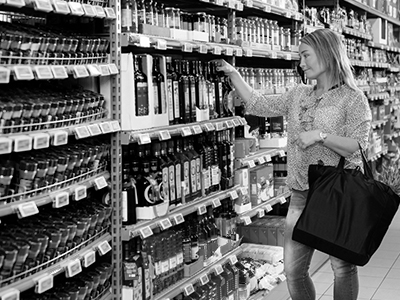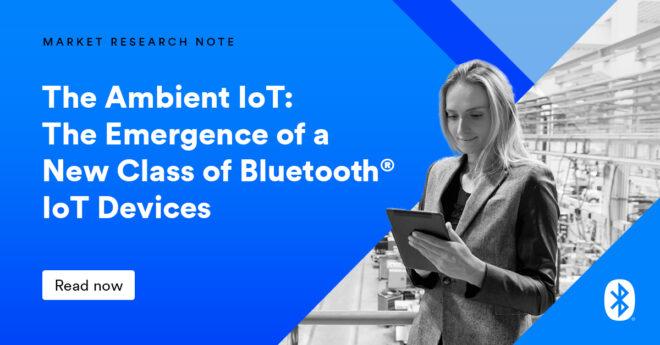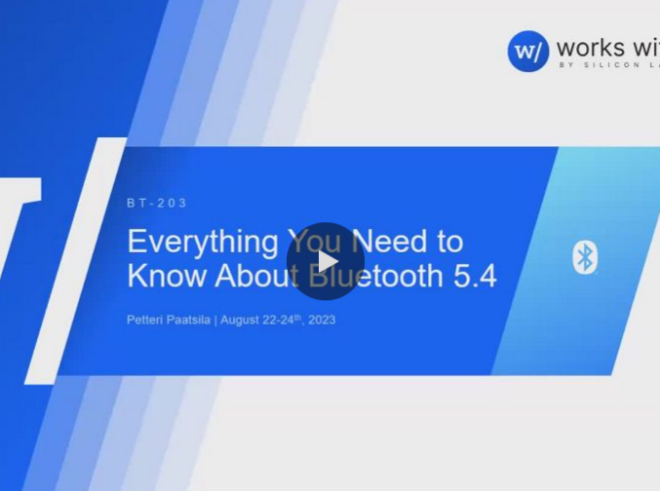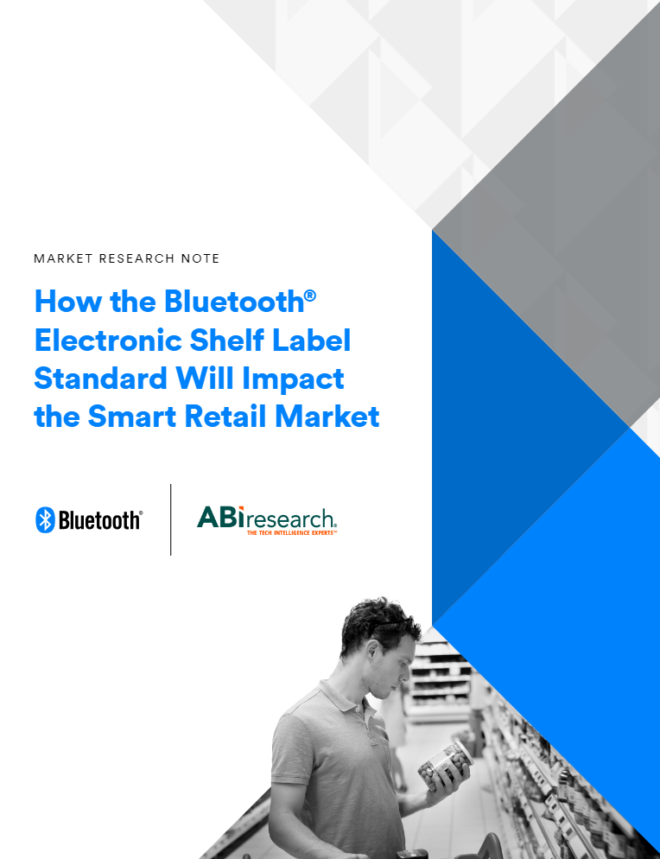
For more than 35 years, Qualcomm Technologies, Inc. has connected products and technologies you interact with every day. Most recently, they’ve devoted efforts to creating a wide range of cutting-edge innovations, from smartphones and gaming devices to technologies that support smart vehicles, smart industry, and smart cities.
Last month, I had a chance to speak with Art Miller, vice president and global head of retail IoT for Qualcomm Technologies, Inc. about how Bluetooth® technology can be used to enhance operations across retail spaces.
Q&A With Art Miller From Qualcomm
How has Bluetooth technology evolved in the retail sector over the past few years?
Bluetooth technology has advanced in the retail sector in recent years, thanks in part to swifter image and data transmission, channel hopping, more robust communication protocol, and a reduction in battery consumption. These improvements have opened the door to new applications that can revolutionize customer experience and business operations, including locationing and geofencing-based use cases and proximity sensing with Bluetooth Low Energy (LE)-enabled devices.
While proprietary networks alone can provide a number of functions, their proprietary nature can also bring limitations when exploring new functionality. Bluetooth LE brings a breadth of new capabilities to complex retail environments that demand electronic shelf labels (ESL), digital shelf systems (DSS), and other IoT devices.
What emerging trends in Bluetooth technology do you see having the biggest impact on the retail industry?
A notable trend in Bluetooth technology for the retail sector is the increasing use of Bluetooth LE for IoT devices, including growing momentum in electronic shelf label implementations. This advancement enables the creation of a unified retail system where IoT devices from various manufacturers can seamlessly communicate and integrate into a single management platform. This has the potential to revolutionize retail operations, driving efficiency, cost savings, and improved security and scalability.
“A notable trend…for the retail sector is the increasing use of Bluetooth® LE for IoT devices.”
Bluetooth technology offers retailers two main benefits: security and scalability. Through our alliance with VusionGroup, Bluetooth technology helps us deliver retailers a comprehensive solution for contextual real-time data, analytics, and positioning capabilities that can be scaled rapidly and reliably.
One of the main challenges that retailers face when adopting electronic shelf labels (ESL), digital shelf systems (DSS), and other IoT devices is scalability. How can they install, manage, and update tens of thousands or even millions of IoT devices across multiple stores without compromising performance, security, or efficiency? How can they ensure a smooth and seamless transition from legacy systems to digital solutions? Bluetooth LE implementation offers several advantages over other wireless protocols.
FEATURED INNOVATION
Bluetooth Electronic Shelf Labels (ESL)
With the introduction of a wireless standard for the electronic shelf label (ESL) market, Bluetooth® technology is helping unlock the next chapter in in-store digital transformation to deliver better retail outcomes for both stores and shoppers.
How can Bluetooth technology improve customer experiences in retail environments?
Bluetooth technology can enable a variety of customer experiences in retail, including through mobile payment systems, item picking, and enhanced system integrations.
“Bluetooth® technology can enable a variety of customer experiences in retail.”
-
- Mobile Payment Systems: Customers can use their smartphones to pay for items at checkout.
- Item Picking: Employees can use Bluetooth enabled devices to track inventory and pick items for customers.
- Enhanced System Integrations: Bluetooth technology facilitates the seamless integration of various store systems, including point-of-sale, inventory management, and customer relationship management systems. This data can be used to optimize retail operations and improve customer experiences by:
- Providing customers with real-time information about product availability and pricing
- Empowering employees with streamlined work processes
- Personalizing the customer experience based on individual preferences
Both Walmart and Ace Hardware recently announced that they will be including Bluetooth LE ESLs in thousands of their stores in the near future.

Beyond electronic shelf labels, what other ways can retailers use Bluetooth technology to enhance their shopper experience?
Retailers can effectively engage customers with Bluetooth enabled features by providing in-store navigation to help customers find products quickly and easily and by offering personalized promotions to customers based on their purchase history or interests. This can help retailers increase sales and improve customer satisfaction.
Can you share any lessons learned from past projects involving the deployment of Bluetooth technology in retail spaces?
We recognize the critical importance of identifying the unique challenges and use cases each retailer faces. This understanding is key to deploying technology in a comprehensive manner that considers the entire store ecosystem and operations. Moreover, integrating with the retailer’s existing architecture can lead to cost efficiencies and expedited deployment.
It is important to understand that Bluetooth® LE is a transformative technology for the retail industry, empowering unprecedented levels of connectivity, interactivity, and intelligence. It is crucial to select a secure and scalable solution crafted by experts in Bluetooth technology and retail innovation. With the right solution, retailers can anticipate higher sales, better labor utilization, targeted promotions, higher profits, and simplified security.
“Over the next three to five years, Bluetooth® technology will continue to revolutionize the retail experience.”
How do you envision the future of Bluetooth technology shaping the retail experience over the next five to ten years?
Over the next three to five years, Bluetooth technology will continue to revolutionize the retail experience. It will be leveraged for a myriad of applications, including pricing automation, operations efficiencies, and customer engagement. Bluetooth technology will also make it easier for retailers to track inventory and manage prices while improving their bottom line by reducing costs to help increase sales.
![]()
FEATURED REPORT
How the Bluetooth® Electronic Shelf Label Standard Will Impact the Smart Retail Market
ABI Research explores how the recent arrival of the new Bluetooth® Electronic Shelf Label (ESL) standard will help create an interoperable ESL ecosystem that can address many of the challenges being faced by retail and other environments.

35年以上にわたり、クアルコムテクノロジーズ(Qualcomm Technologies, Inc.)は日常生活に欠かせない機器や家電製品と様々な技術をつなぐことにより、人々の生活をより豊かにしてきました。近年はスマートフォンやゲーム機から、スマートビークル、スマート産業、スマートシティを支える技術まで、最先端イノベーションの幅広い開発に注力しています。
先月、クアルコムテクノロジーズのバイスプレジデント兼リテールIoTグローバル責任者のアート・ミラー(Art Miller)氏と対談し、Bluetooth®技術が小売分野でどのように業務改善に活用できるかについてお話を伺いました。
クアルコムテクノロジーズのアート・ミラー氏とのQ&A
この数年、小売分野におけるBluetooth技術はどのように進化していますか。
近年、Bluetooth技術の小売分野における進展は顕著です。これは、画像・データ伝送の高速化、チャネルホッピング、より堅牢性の高い通信プロトコル、バッテリー消費の削減などが寄与しています。これらの性能向上は、位置特定やジオフェンシングに基づくユースケース、Bluetooth Low Energy(LE)対応デバイスを使用した近接センサーなど、顧客体験や業務形態を大きく変えるような新しいアプリケーションの可能性をもたらしました。
独自規格のネットワークのみで数多くの機能を提供することも可能ですが、独自規格であることが、新しい機能を検討する際の制約となる場合もあります。実際Bluetooth LEによって、電子棚札(ESL)やデジタルシェルフシステム(DSS)、その他IoTデバイスを要する幅広い種類の新機能が、小売現場の複雑な環境で生まれました。
Bluetooth技術について新しく見られるトレンドの中で、小売業に最も大きく影響するのはどのトレンドだと思いますか。
小売業におけるBluetooth技術で注目されるトレンドは、ESLの実装での成長を含め、IoTデバイスでのBluetooth LEの使用が拡大していることです。この進展により、さまざまなメーカーのIoTデバイスがシームレスに通信し、一つの管理プラットフォームの下に組み込まれるような、統合リテールシステムの構築が可能になっています。これは効率化、コスト削減、セキュリティ強化と拡張性の向上の推進力となり、小売販売業務を改革する可能性を秘めています。
Bluetooth技術が小売企業にもたらすのは、主に「セキュリティ」と「拡張性」という2つのメリットです。当社とVusionGroupとの提携を通じて、Bluetooth技術は、小売業向けの包括的ソリューションの実現に貢献してくれました。そのソリューションはリアルタイムのコンテキストデータ、分析、位置特定などの機能を持ち、迅速かつ信頼性を持って拡張できます。
ESL、DSS、その他のIoTデバイスを採用する際、小売企業が直面する課題の一つが拡張性です。万単位、ときには百万単位のIoTデバイスを、パフォーマンスやセキュリティ、効率性を損なうことなく複数の店舗に設置し、管理・更新していくには、どうすれば良いでしょうか。旧来の体制からデジタルシステムへの移行を、円滑かつシームレスに行うにはどうすれば良いでしょう。Bluetooth LEを実装することで、他のワイヤレスプロトコルにはない複数のメリットが得られます。
Bluetooth技術によって、小売現場の顧客体験はどのように向上できるでしょうか。
Bluetooth技術は、モバイル決済システム、ピッキング作業、システム統合の強化など、小売販売におけるさまざまな顧客体験を実現できます。
-
- モバイル決済システム:買い物客がレジでの支払いにスマートフォンを利用できます。
- ピッキング作業:従業員がBluetooth搭載デバイスを使用して在庫を探し、買い物客のために商品をピッキングできます。
- システム統合の強化:Bluetooth技術によって、POS、在庫管理、顧客関係管理(CRM)をはじめとする各種店舗システムのシームレスな統合が促進されます。ここで得たデータは、小売販売業務の最適化や、以下による顧客体験の向上に使用できます。
- 商品の在庫状況と価格に関するリアルタイム情報の提供
- 合理化された業務プロセスによる従業員のエンパワーメント
- 個人の好みに基づいた顧客体験のパーソナライズ
ウォルマート(Walmart)とエース・ハードウェア(Ace Hardware)の両社は、近い将来、数千店舗でBluetooth LEのESLを展開していくと発表しています。

ESLのほかに、買い物客の体験向上に使用できるBluetooth技術にはどのようなものがありますか。
店舗内ナビゲーションによる案内で、買い物客が探している品物を迅速かつ容易に見つけられるようにしたり、購入履歴や関心に基づいてパーソナライズされた販促施策を提供したりと、Bluetoothを活用した機能で顧客エンゲージメントを効果的に高めることができます。これは、売上の拡大と顧客満足度の向上にもつながります。
小売分野でのBluetooth技術の導入に関連し、過去のプロジェクトから得た教訓はありますか。
当社は、小売企業がそれぞれ直面している独自の課題とユースケースを把握することが極めて重要だと認識しています。この点への理解が、店舗のエコシステムおよび業務全体を考慮し、技術を包括的に展開する上での鍵となります。さらに、既存のアーキテクチャとの統合が、コスト効率や迅速な導入につながる場合もあります。
重要なのは、Bluetooth® LEが小売業にとって変革をもたらす技術であり、かつてないレベルで、接続性や対話性、インテリジェンスを実現できることへの理解です。Bluetooth技術と小売業におけるイノベーションの専門家によって構築された、安全性と拡張性の高いソリューションを選ぶことが肝心です。適切なソリューションがあれば、小売業者は、売上拡大、労働力活用の効率化、的を絞った販促活動、収益向上、簡素化されたセキュリティの実現を期待できます。
今後5年から10年間で、Bluetooth技術は小売店舗における顧客体験に将来的にどのような影響を与えるとお考えですか。
今後の3年から5年にわたり、Bluetooth技術は小売店舗における顧客体験を大きく変え続けていくと思います。価格表示の自動化、業務効率化、顧客エンゲージメントなど、無数の用途に活用されると考えています。Bluetooth技術は、小売業の在庫管理と価格管理をより容易なものにする一方で、売上拡大に要するコストの削減によって、収益向上を図ることも容易にするでしょう。










![hqdefault[1]](https://www.bluetooth.com/wp-content/uploads/2023/08/hqdefault1.jpg)
















